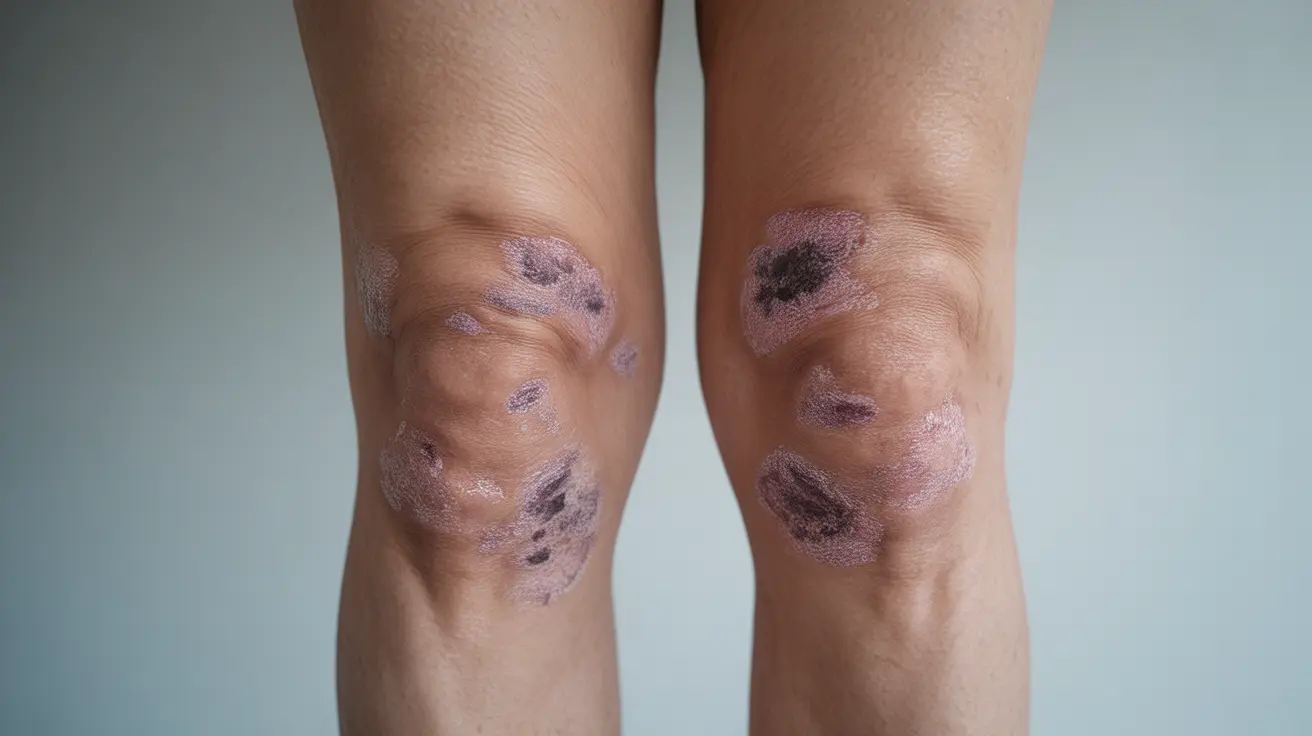Living with psoriasis on the knees can significantly impact daily comfort and mobility. This chronic autoimmune condition causes patches of thick, scaly skin to develop on the knee area, affecting both the front of the knee and the sensitive skin behind it. Understanding how to identify, manage, and treat knee psoriasis is crucial for maintaining quality of life and preventing complications.
Whether you're newly diagnosed or seeking better ways to manage your condition, this comprehensive guide will help you understand the unique challenges of knee psoriasis and explore effective treatment options.
Recognizing Psoriasis Symptoms on the Knees
Psoriasis manifests differently on various skin tones, but certain characteristic signs remain consistent. On lighter skin, psoriasis typically appears as red or pink patches with silvery-white scales. On darker skin tones, the patches may appear purple or dark brown, with gray scales.
Common symptoms include:
- Thick, raised patches of skin (plaques)
- Dry, cracked skin that may bleed
- Itching and burning sensations
- Stiffness and discomfort when bending the knee
- Skin that feels tender or painful to touch
Special Considerations for Behind-the-Knee Psoriasis
The area behind the knee presents unique challenges due to its frequent movement and tendency to accumulate moisture. This location often experiences:
- More frequent cracking and fissuring
- Increased irritation from friction
- Higher risk of infection due to moisture retention
- Greater discomfort during movement
Common Triggers and Flare-Up Factors
Several factors can trigger or worsen psoriasis on the knees:
- Physical trauma or injury to the knee area
- Friction from clothing or athletic activities
- Stress and anxiety
- Weather changes, particularly cold and dry conditions
- Certain medications
- Infections or illness
Treatment Approaches for Knee Psoriasis
Medical Treatments
Healthcare providers may recommend various medical interventions:
- Topical corticosteroids
- Vitamin D analogues
- Calcineurin inhibitors
- Phototherapy
- Oral or injectable medications for severe cases
Effective Home Remedies
Several at-home strategies can help manage symptoms:
- Regular moisturizing with fragrance-free products
- Gentle cleansing with mild soap
- Warm (not hot) baths with colloidal oatmeal
- Application of natural moisturizers like coconut oil
- Using soft, breathable fabric over affected areas
Preventing Complications and Managing Long-Term Health
Regular monitoring and preventive care are essential for managing knee psoriasis effectively. Pay attention to signs of psoriatic arthritis, which can develop in some cases. Early intervention can help prevent joint damage and maintain mobility.
Lifestyle Modifications for Better Management
Making certain lifestyle changes can significantly improve symptoms:
- Wearing loose-fitting, comfortable clothing
- Maintaining a healthy weight to reduce knee stress
- Regular, gentle exercise that doesn't irritate the skin
- Stress management techniques
- Following a balanced, anti-inflammatory diet
Frequently Asked Questions
What are the common symptoms of psoriasis on the knees and how does it look on different skin tones? Symptoms include thick, scaly patches that appear red or pink with silvery scales on light skin, and purple or dark brown with gray scales on darker skin. Common signs include itching, burning, and discomfort during knee movement.
What triggers psoriasis flare-ups specifically on the knees and behind the knees? Common triggers include physical trauma, friction from clothing, stress, weather changes, certain medications, and infections. The area behind the knee is particularly susceptible due to moisture accumulation and frequent movement.
How is psoriasis on the knees treated, including both at-home remedies and medical options? Treatment combines medical interventions like topical medications, phototherapy, and systemic treatments with home remedies such as regular moisturizing, gentle cleansing, and using natural products. The approach often needs to be personalized for each individual.
Can psoriasis on the knees lead to psoriatic arthritis, and what are the signs to watch for? Yes, some people with knee psoriasis may develop psoriatic arthritis. Watch for joint pain, stiffness, swelling, and reduced range of motion in the knee joint. Early detection and treatment are crucial.
What lifestyle changes can help prevent or reduce psoriasis symptoms on the knees? Key lifestyle modifications include wearing appropriate clothing, maintaining a healthy weight, regular exercise, stress management, and following an anti-inflammatory diet. Consistency in skin care routines is also essential.




